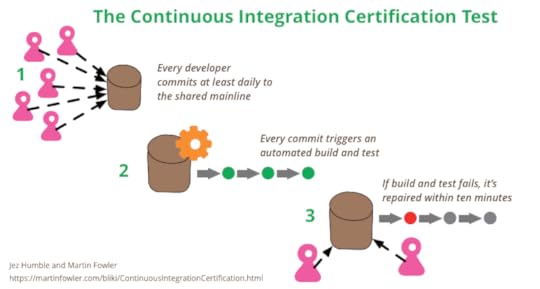Bliki: ContinuousIntegrationCertification
Continuous Integration is a popular technique in software development. At conferences
many developers talk about how they use it, and Continuous Integration tools are common
in most development organizations. But we all know that any decent technique needs a certification
program — and fortunately one does exist. Developed by one of the foremost experts in
continuous delivery and devops, it’s known for being remarkably rapid to administer, yet
very insightful for its results. Although it’s quite mature, it isn’t as well known as
it should be, so as a fan of the technique I think it’s important for me to share this
certification program with my readers. Are you ready to be certified for Continuous
Integration? And how
will you deal with the shocking truth that taking the test will reveal?
By now my regular readers are wondering if they’ve come across a parody post [1], and yes
I am having a little fun with my opening teaser. But like any good joke there’s an
important kernel of truth buried in it. There is a remarkably good test for proper
Continuous Integration that was created by Jez Humble - and he certainly is a leading
expert in ContinuousDelivery. It’s also a rapid test, he often administers it to his
audience during his talks. The only problem is that I’ve never heard him refer to it as a
certification test - which just shows his lack of vision for money-making schemes.
He usually begins the certification process by asking his audience to raise their
hands if they do Continuous Integration. Usually most of the audience raise their hands.
He then asks them to keep their hands up if everyone on their team commits and pushes
to a shared mainline (usually shared master in git) at least daily.
Over half the hands go down.
He then asks them to keep their hands up if each such commit causes an automated
build and test. Half the remaining hands are lowered.
Finally he asks if, when the build fails, it’s usually back to green within ten
minutes. [2]
With that last question only a few hands remain. Those are the people who pass his
certification test.

It’s a simple set of questions, but it gets to the core of what Continuous
Integration is about. The whole idea is that nobody is working on a code base that
deviates significantly from anyone else’s. Continuous Integration means the team knows
what the current state of the code truly is, we avoid big risky merges, and people can
refactor as much as they need to.
The reason so many people raise their hands at the beginning is the common view that
Continuous Integration means running some “Continuous Integration Server” against their
feature branches. But Continuous Integration — as it was originally described and named
by Kent Beck as part of ExtremeProgramming — has nothing to do with tools. At the
beginning it was a human workflow and Jim Shore made an excellent argument that it
should be that. The idea of running a daemon process against a source code
repository came later, and while it is helpful, it’s only Continuous Integration if it’s
run on a shared mainline that people commit to every day. Running such a daemon
otherwise, such as on every FeatureBranch, is Daemonic Continuous Integration that debases the name [3], yielding a workflow that doesn't give you the benefits that make the whole
thing worth the effort.
Further Reading
For more details on Continuous Integration, see my main
article, while written in 2006 it's still a solid summary and definition of the
technique. Jez explains why Continuous Integration is a foundation
for Continuous Delivery. He states the three questions in the FAQ on that page.
Paul Duvall wrote the definitive book on Continuous
Integration. Watch Jez administer the certification test
at GOTO Chicago in 2014 (sadly there was no camera on the audience).
Acknowledgements
All credit for the three questions go to Jez, whose talks I've always enjoyed. A
conversation with Paul Hammant triggered me to come up with the term Daemonic
Continuous Integration, which I hope will catch on for this particularly annoying
piece of cargo culting.
Notes
1:
In general, I'm not a fan of software certification schemes, as they usually fail
the CertificationCompetenceCorrelation
2:
For this step, "green" counts as passing the commit
build, typically compilation and unit tests. While we usually expect a full
DeploymentPipeline to be run for release to production, a repository
should be fine for developers to work on after the commit build is green. You should
have a commit build that takes no more than ten minutes, so quickly fixing it and
re-running the commit build works if the fix is easy. If you can't fix and get a
green commit build within ten minutes, then you should revert to the last green build.
3:
The problem of Daemonic Continuous
Integration leads some people to use the name Trunk-Based Development, arguing that
SemanticDiffusion has rendered the term “Continuous Integration” useless.
While I understand their view, I believe that we shouldn’t give in to semantic
diffusion, instead we need to keep working at re-explaining the proper meaning of
Continuous Integration, just as we should with other terms under this kind of semantic
assault (such as “agile” and “refactoring”).
Share:



if you found this article useful, please share it. I appreciate the feedback and encouragement
Martin Fowler's Blog
- Martin Fowler's profile
- 1103 followers



